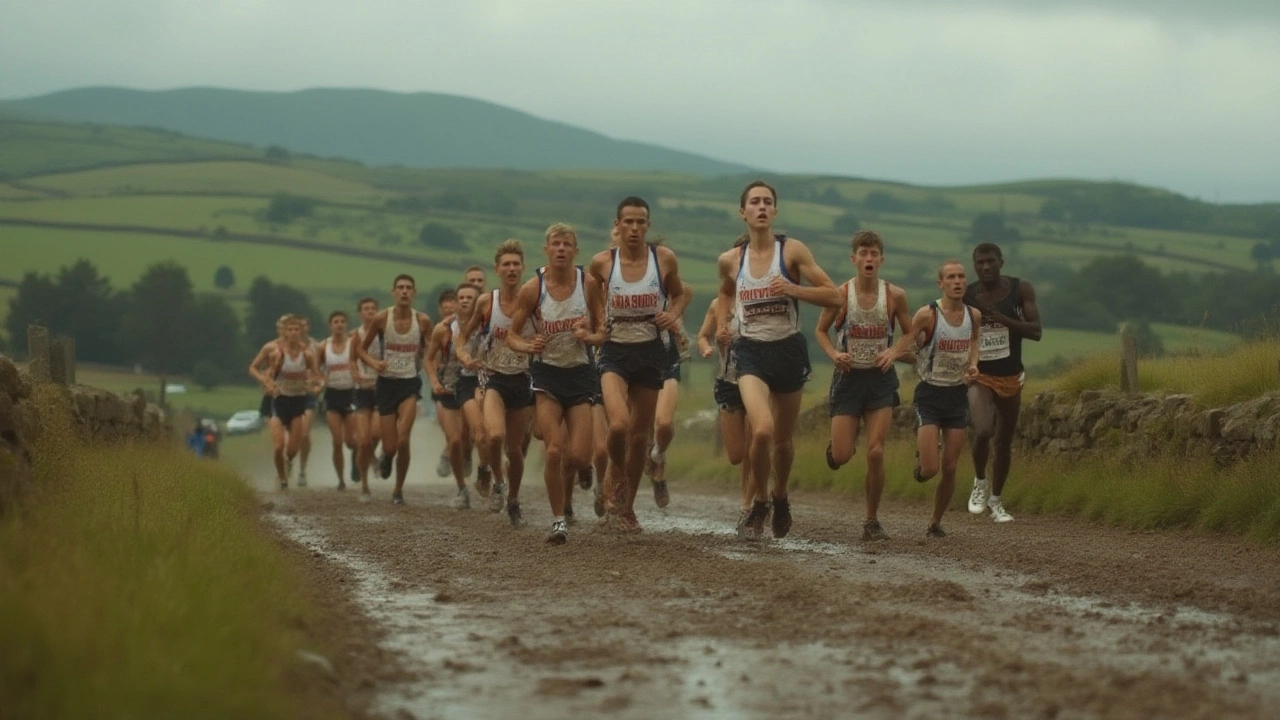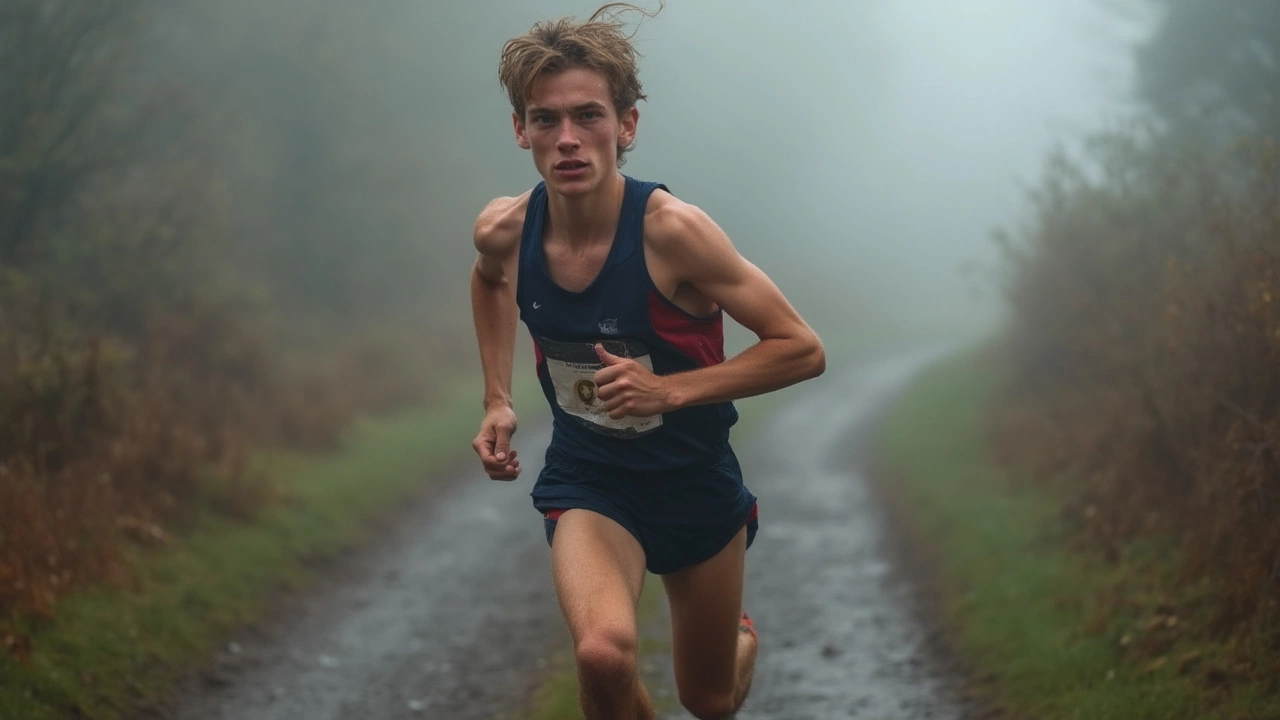Why Are XC Runners So Skinny? Factors Behind Cross Country Runner Body Types

You’ve probably seen them—the cross country kids gliding across trails with stick-thin legs, shorts barely clinging to their hips, and arms that could almost vanish in a stiff breeze. They look like they were born to run, and in a way, maybe they were. But there’s much more going on than what you can spot in the halls or on a start line. Those lean bodies are a product of nature, nurture, and more than a few wild training sessions.
The Science Behind the Skinny: Body Fat, VO2 Max, and More
Cross country running is brutal on the body. The sport demands high mileage, intense intervals, and lots of energy-burning long runs. Week after week, these athletes burn hundreds—sometimes thousands—of extra calories. In fact, a typical varsity XC runner at a competitive high school or college might clock 40 to 70 miles per week, and that quickly stacks up caloric demands. Imagine burning an extra 3,000–6,000 calories weekly just from running alone. No wonder so many runners seem to vanish when they turn sideways.
It’s not just about burning calories. XC runners rely on something called VO2 max—basically, how much oxygen your body can use when working hard. The higher your VO2 max, the better your body is at using oxygen to create energy for your muscles. According to a frequently-cited study in the Journal of Applied Physiology, elite distance runners often boast VO2 max values above 70 ml/kg/min for men and 60 ml/kg/min for women—much higher than the average person. These numbers are connected to low body fat; it’s harder to transport oxygen if the body is carrying excess weight. Lower fat generally means less useless weight to move and better performance.
Now, stick-thin doesn’t mean unhealthy. Many of these athletes are stronger than they look, with high muscle efficiency and lower body fat percentages—sometimes in the single digits. Stanford’s sports medicine team published a report noting male collegiate distance runners often show body fat percentages around 5–9%, and women generally fall between 10–15%. That’s leaner than most other sports—possibly only gymnasts or some cyclists compare. For comparison, here’s a quick table of typical body fat ranges for various athletes:
| Sport | Men's Body Fat % | Women's Body Fat % |
|---|---|---|
| Cross Country Running | 5–9% | 10–15% |
| Football (Quarterback) | 12–18% | N/A |
| Swimming | 10–16% | 14–22% |
| Gymnastics | 5–12% | 10–16% |
High mileage, low body fat, extra-efficient cardiovascular systems—that’s the recipe behind the skinny runner look. But there’s more to the story.
Fueling the Engine: How Diet Shapes Runners' Bodies
Training burns a lot of energy, but what runners eat can matter just as much as the miles they log. Most XC runners don’t chase low-calorie diets on purpose—their bodies and appetites do most of the work. Training hard, especially at a young age, tends to ramp up metabolism. Sometimes, athletes struggle to eat enough to match what they burn. Have you ever seen a runner wolf down several plates of pasta after a long run? That’s because, for many, hunger seems never-ending after knocking out double-digit mileage.
The big nutrients? Carbohydrates rule the menu—think bagels, bananas, rice, pasta, granola. Why? Carbs refuel glycogen, the quick-burn energy stored in muscles. Runners can get away with eating more carbs than most people, and they need to; low carb intake is a shortcut to sluggish legs and bad race days. Proteins and healthy fats aren’t forgotten, but the emphasis stays on what can be digested quickly and turned into energy.
Here’s a sample daily diet for a serious cross country runner during heavy training:
- Breakfast: Oatmeal with almonds and dried fruit; two eggs; orange juice
- Snack: Greek yogurt with granola; apple
- Lunch: Turkey sandwich; sweet potato; steamed greens
- Snack: Banana with peanut butter; bagel
- Dinner: Grilled chicken breast, rice, broccoli, mixed salad
- Post-practice: Low-fat chocolate milk; handful of pretzels
Eating healthy is crucial, but it's also about eating often. The cycle of running, refueling, and repeating is relentless. Runners with very thin body types often face scrutiny or concern, with some (incorrectly) assuming they’re under-eating or unhealthy. While there are risks of under-fueling, most serious programs include nutrition education and regular health checks. Nutritionist Nancy Clark once put it this way:
“Distance runners aren’t thin because they eat too little. They’re thin because their bodies demand efficiency—it’s the price of the sport.”
Of course, sometimes the line between healthy skinny and too skinny blurs, which can be a problem in the sport, but that’s not the norm for most athletes with a good support system.
Genetics: Not Everyone Is Built To Be Skinny
Not all runners are naturally skinny. Some cross country champions have broader shoulders or stockier frames, and they still crush records. Genes play a huge part. Studies show some people have natural muscle-fiber types and body compositions that make them more efficient at burning fuel and carrying less extra mass. Others, even with similar training, keep more muscle or have different proportions.
The “runner’s build” is often seen as a long, narrow torso, short upper body, long limbs, and low-ish body fat. But that’s just one picture. Legendary Ethiopian distance runners often stand out for their slight upper bodies and incredibly powerful (but not bulky) legs. American XC stars come in plenty of shapes—just look at NCAA finish lines for proof.
Body type matters, yes, but so does muscle efficiency. Having a higher percentage of slow-twitch muscle fibers makes a big difference for endurance and doesn’t necessarily mean a person will look stick-thin. Fast-twitch muscle fibers give more size but are less helpful for running 5–10 kilometers quickly. Dr. Ross Tucker, sports physiologist, summed it up in an interview:
“Elite distance running is as much about genetics as training. Two people can run the same program but look and perform very differently.”
So, while many top XC runners are skinny, it’s partly just luck of the genetic draw mixed with some smart training and fueling. Of course, adaptation matters—the longer someone sticks with the sport, the more likely their body leans out over time. That’s how bodies tend to respond to years of consistent distance running.

The Demands of Training: Mileage, Recovery, and the Cost of Speed
The cross country season is relentless. Unlike sprinters or power athletes, most distance runners are on the move day after day, rarely taking more than one rest day each week, if that. Practices stack up quickly, and summer training doesn’t allow for much downtime. Run easy on Monday, intervals on Tuesday, tempo on Thursday, long run on Saturday—it’s a cycle that never quite lets up.
In even a “light” XC season, varsity runners may log 40–60 miles per week. In peak college, or elite high school programs that number can push past 70 miles. It’s tough work, and the sheer amount of time on their feet ruins any hope of hanging on to extra body fat. Practically speaking, the body adapts by getting rid of excess insulation that just slows things down. There’s a saying among distance coaches: “Fat doesn’t get you up the hill faster.”
It’s not all mileage, though. Recovery has its price too. Hard workouts eat up reserves, and serious runners often avoid heavy strength work that might add muscle mass where it isn’t needed. Instead, they focus on low-weight, high-rep exercises, plyometrics, or form drills that encourage lean, powerful muscles without bulk. The goal: build just enough strength to avoid injury, but not so much it weighs you down. My own cat, Oliver, probably has bulkier quads from chasing after his catnip toys than many top runners—if only he could run a 5K.
Pacing matters, too. Training at threshold—just below maximum effort—teaches the body to become a fat-burning machine, especially over long distances. This means runners’ bodies are constantly, efficiently using their fuel reserves and keeping extra mass off. Burn more calories than you put in, over time, and the result is a lean frame.
But it’s less about achieving “skinniness” and more about finding the shape that works for running fast longest. Most coaches focus on functional fitness—what works for the sport—rather than appearances. Personal bests and championship results are better markers of success than what a runner looks like in uniform.
Body Image, Health Risks, and Breaking the Stereotypes
Athletics are supposed to be healthy, but the “skinny runner” myth can go too far. Exercise scientists and sports psychologists warn that body image problems are common in sports with obvious body archetypes. Runners might compare themselves to teammates or pros, worrying that extra weight is holding them back. Sometimes, that can push athletes to unhealthy extremes.
The best teams fight this by normalizing all types of healthy bodies. Coaches are trained now, more than ever, to spot signs of disordered eating or exercise obsession. Most college programs do regular health checks, including bone density scans for women and body composition for all. The emphasis is shifting: health first, speed second. In fact, programs like the NCAA and UK Athletics now officially recommend minimum body weight checks and stress nutrition over appearance.
What are the dangers? Losing too much weight can seriously harm performance—or worse, health. Female runners who drop too much body fat can develop Relative Energy Deficiency in Sport (RED-S), leading to missed periods, stress fractures, or worse. Men face similar issues, suffering from fatigue, low hormone levels, or injury. No race record is worth risking long-term health.
The cultural conversation is changing, finally. Role models now include a wider range of body types, and there’s less shame for athletes who don’t fit a “stick-thin” ideal. Running is about working with, not against, the body you have. Some of the most successful cross country runners in history, like Paula Radcliffe or Galen Rupp, don’t look exactly alike—and their ability to stay healthy was a huge part of their greatness.
If you’re a young runner or a parent reading this, know that real success comes from being strong, happy, and able to run without restriction. Thinness is a side effect for some, never the main ingredient.
Tips for Runners: Thriving With Your Own Body Type
If you dream of joining your school’s cross country team but feel like you don’t “look” like a runner, ignore the stereotypes. Here’s what really matters:
- Consistency beats extremes. Build up your mileage bit by bit—no crash diets or last-minute mileage binges.
- Fuel for function, not appearance. Listen to your appetite and don’t skimp, especially during hard training blocks.
- Stay strong—mix in injury-preventing strength work like core, balance, and stability exercises.
- Sleep is not optional. Your body rebuilds on rest as much as on nutrition.
- Choose gear that fits your body, not what looks best in ads. A great pair of shoes or shorts in the right size beats flashy brands every time.
- Ask for help if you struggle with body image or have questions about nutrition. Coaches, athletic trainers, and dietitians are there for you.
Cross country running isn’t just for the ultra-thin. Every year, runners with all sorts of backgrounds and body types find their stride. Some may get lean, others less so—but all get the joy of a sport that rewards commitment, resilience, and teamwork. Whether you’re dashing through muddy trails, chasing PRs on the track, or just trying to keep up with a runaway pet (looking at you, Oliver), running is bigger than body shape. That’s the magic of XC—guts, grit, good friends, and a finish line worth chasing, no matter the muscle or fat percentages.
